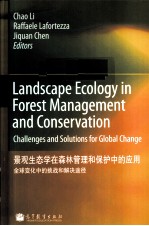

全球变化中的挑战和解决途径 英文版PDF电子书下载
- 电子书积分:14 积分如何计算积分?
- 作 者:Chao Li,Raffaele Lafortezza,Jiquan Chen
- 出 版 社:北京:高等教育出版社
- 出版年份:2010
- ISBN:9787040291360
- 页数:403 页
Part Ⅰ Landscape Ecology and Forest Management 3
Chapter 1 Managing Forest Landscapes under Global Change Scenarios 3
1.1 Introduction 4
1.2 Forest management 6
1.3 New challenges in a changing globe 17
1.4 Landscape ecology contributions 19
1.5 Conclusion remarks 20
References 20
Chapter 2 Landscape Ecology Contributions to Forestry and Forest Management in China:Progresses and Research Needs 22
2.1 Introduction 23
2.2 China's forestry and forest management 25
2.3 Challenges and emerging global issues in forestry 32
2.4 Contributions of landscape ecology to forest management and conservation 34
2.5 Research needs for forest landscape management 37
2.6 Concluding remarks 40
Acknowledgements 41
References 41
Chapter 3 Issues Facing Forest Management in Canada,and Predictive Ecosystem Management Tools for Assessing Possible Futures 46
3.1 A brief history of forestry in Canada 47
3.2 Canada's lands and forests 49
3.3 Issues facing forestry in Canada today 51
3.4 How can Canadian forestry respond to these and other issues?One way is ecosystem management modeling 60
3.5 Conclusions 67
References 68
Part Ⅱ Modeling Disturbance and Succession in Forest LandscapesChapter 4 Challenges and Needs in Fire Management:A Landscape Simulation Modeling Perspective 75
4.1 Introduction 76
4.2 Simulation modeling in fire management 77
4.3 Technical challenges in fire management modeling 79
4.4 A fire management simulation example 82
4.5 Research and management needs and solutions 89
4.6 Summary 92
References 93
Chapter 5 Using Landscape Disturbance and Succession Models to Support Forest Management 99
5.1 Introduction 100
5.2 Overview of landscape disturbance and succession models 101
5.3 Case studies 103
5.4 General conclusions 113
5.5 Future of LDSMs in decision-making 115
Acknowledgements 116
References 116
Chapter 6 Research Methods for Assessing the Impacts of Forest Disturbance on Hydrology at Large-scale Watersheds 119
6.1 Introduction 120
6.2 Definition of large-scale watersheds 122
6.3 Quantification of forest disturbance 123
6.4 Research methods on assessing impacts of forest disturbance on hydrology at large-scale watersheds 126
6.5 Future directions 138
6.6 Conclusions 140
Acknowledgements 141
References 141
Chapter 7 Software Applications to Three-Dimensional Visualization of Forest Landscapes—A Case Study Demonstrating the Use of Visual Nature Studio(VNS)in Visualizing Fire Spread in Forest Landscapes 148
7.1 Introduction 149
7.2 Forest landscape visualization 150
7.3 Results and discussion 167
7.4 Conclusion 172
7.5 Future wildfire visualization research 173
Acknowledgements 174
References 174
Chapter 8 Predicting Tree Growth Dynamics of Boreal Forest in Response to Climate Change 176
8.1 Introduction 176
8.2 Materials and methods 178
8.3 Results 191
8.4 Discussion 198
8.5 Conclusions 202
Acknowledgements 202
References 203
Part Ⅲ Emerging Approaches in Forest Landscape Conservation 209
Chapter 9 The Next Frontier:Projecting the Effectiveness of Broad-scale Forest Conservation Strategies 209
9.1 Introduction 210
9.2 Template project:Wild Rivers Legacy Forest and Two Hearted River Watershed 220
9.3 Conclusions and implications:Pushing the frontier 226
References 227
Chapter 10 Forest Avian Species Richness Distribution and Management Guidelines under Global Change in Mediterranean Landscapes 231
10.1 Introduction 232
10.2 Material and methods 236
10.3 Results and discussion 239
10.4 Concluding remarks and forest management guidelines 247
Acknowledgements 248
References 248
Chapter 11 Development of a Forest Network System to Improve the Zoning Process:A Case Study in Japan 252
11.1 Background of the Japanese forest policy and methodological problems 253
11.2 State of the public participation 257
11.3 How to improve the current zoning process 260
11.4 On the effective use of social backgrounds and evaluation 263
11.5 Experts vs.the general public 267
11.6 Perspectives of the future 269
References 270
Chapter 12 Forest Fragmentation:Causes,Ecological Impacts and Implications for Landscape Management 273
12.1 Fragmentation:A plenitude of definitions 274
12.2 Demographic development and anthropogenic activity as drivers of fragmentation 277
12.3 Empirical evidences of the impact of fragmentation on biodiversity 282
12.4 Implications for landscape management—conclusions 287
Acknowledgements 292
References 292
Part Ⅳ Practicing Sustainable Forest Landscape Management 299
Chapter 13 Application of Landscape and Habitat Suitability Models to Conservation:The Hoosier National Forest Land-management Plan 299
13.1 Introduction 300
13.2 Methods 303
13.3 Results 308
13.4 Discussion 320
13.5 Recommendations for future planning efforts 324
Acknowledgements 325
References 325
Chapter 14 Agriculture Abandonment,Land-use Change and Fire Hazard in Mountain Landscapes in Northeastern Portugal 329
14.1 Introduction 330
14.2 Methodology 333
14.3 Results 337
14.4 Discussion 345
14.5 Implications for management 346
14.6 Conclusion 347
Acknowledgements 348
References 348
Chapter 15 Overview of Biodiversity Loss in South America:A Landscape Perspective for Sustainable Forest Management and Conservation in Temperate Forests 352
15.1 Introduction 353
15.2 The biological importance of the native temperate forests of South America 357
15 3 Threats to native forests 358
15.4 Forest management and conservation strategies:A response to native forests'threats 363
15.5 Management solutions:Modeling dynamics of forest ecosystems 366
15.6 Conclusions 370
References 372
Chapter 16 Conservation of Biodiversity in Managed Forests:Developing an Adaptive Decision Support System 380
16.1 Introduction 381
16.2 Methods 382
16.3 Results 387
16.4 Discussion 391
Acknowledgements 394
References 394
Appendix 398
Index 400
- 《卓有成效的管理者 中英文双语版》(美)彼得·德鲁克许是祥译;那国毅审校 2019
- 《AutoCAD 2018自学视频教程 标准版 中文版》CAD/CAM/CAE技术联盟 2019
- 《跟孩子一起看图学英文》张紫颖著 2019
- 《AutoCAD机械设计实例精解 2019中文版》北京兆迪科技有限公司编著 2019
- 《气候变化与环境治理研究》生态环境部环境与经济政策研究中心编著 2019
- 《变化环境下的生态水文效应模拟》李琼芳著 2019
- 《复分析 英文版》(中国)李娜,马立新 2019
- 《中国大学英语教学“中国文化失语症”的解决路径》刘洋著 2019
- 《未来管理的挑战》包政 2020
- 《张世祥小提琴启蒙教程 中英文双语版》张世祥编著 2017
- 《中国将称霸21世纪吗?》(美)弗格森 N. (Niall Ferguson),亨利·季辛吉(Dr.Henry Kissinger),李稻葵(David Daokui Li),Fareed Zakaria著;廖彦博译 2012
- 《德克·希拉茨 认知社会语言学十讲》李福印;张炜炜,高远主编;Thomas Fuyin Li,Weiwei Zhang,Yuan Gao 2012
- 《痛风美味家常套餐 嘌呤全控制》周薇丽编著;Toku Chao摄影 2004
- 《高钙成长美味家常套餐 存骨本防骨松》周薇丽编著;Toku Chao摄影 2004
- 《水相有机反应大全》Chao-JunLi等著 2009
- 《犯罪学》(意)加罗法洛(Baron Raffaele Garofalo)著;耿伟,王新译 1996
- 《Java 2 平台安全技术 结构、API设计和实现》(美)李宫(Li Gong)著;王运凯等译 2000
- 《CMOS电路设计·布局与仿真》(美)R. Jacob Baker,(美)Harry W. Li,(美)David E. Boyce著;陈中建主译 2006
- 《当代新药合成》(美)Jie-Jack Li等原著;施小新,秦川译 2005
- 《凡·高》Li Yanru译 2004
- 《全国高等中医药行业“十三五”创新教材 中医药学概论》翟华强 2019
- 《培智学校义务教育实验教科书教师教学用书 生活适应 二年级 上》人民教育出版社,课程教材研究所,特殊教育课程教材研究中心编著 2019
- 《指向核心素养 北京十一学校名师教学设计 英语 七年级 上 配人教版》周志英总主编 2019
- 《习近平总书记教育重要论述讲义》本书编写组 2020
- 《办好人民满意的教育 全国教育满意度调查报告》(中国)中国教育科学研究院 2019
- 《高等数学试题与详解》西安电子科技大学高等数学教学团队 2019
- 《北京生态环境保护》《北京环境保护丛书》编委会编著 2018
- 《教育学考研应试宝典》徐影主编 2019
- 《语文教育教学实践探索》陈德收 2018
- 《家庭音乐素养教育》刘畅 2018
